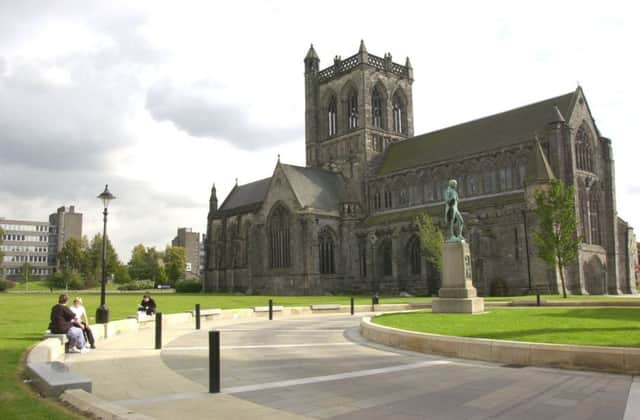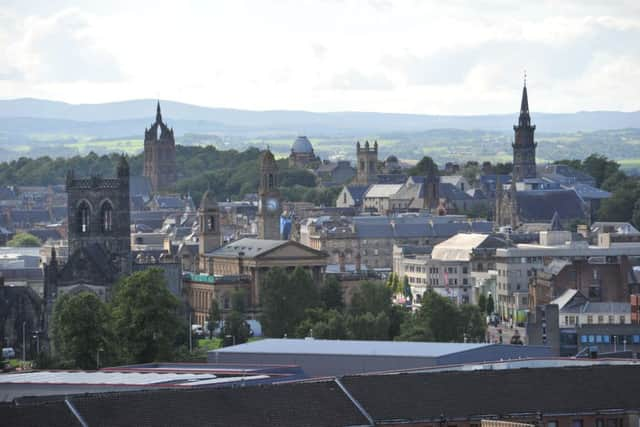What city of culture candidate Paisley has given the world


As a former industrial hub, which has not had its troubles to seek in recent years, it would have been easy for those unfamiliar with the town to dismiss Paisley’s city of culture bid as wishful thinking.
But the former royal burgh has been at the heart of some of the biggest social, creative and political movements in Scottish history. Whether its Hollywood actors, multi-award winning musicians or cutting edge inventors, Paisley has contributed much to the country’s cultural fabric.
Paisley pattern
Advertisement
Hide Ad

By the mid-19th century Paisley was an internationally recognised hub of textile production, with more than 7000 weavers working in the town. At the centre of this flourishing industry was the “Paisley pattern,” a distinctive, teardrop-like design. Despite having its roots in 11th century Kashmir, it became synonymous with the town thanks to the mass production of the Paisley shawl - a high fashion item among women at the time after being worn by a young Queen Victoria.
More shawls were manufactured in the town than anywhere else in the world. Innovative production methods allowed skilled weavers to create abstract combinations of up to 15 colours, while other manufacturers could barely manage five. Paisley’s production of the shawls was so prolific that similar weavers in much larger cities - including Edinburgh and Glasgow - were forced to cease production.
The heyday of the Paisley shawl was brought to an end in the 1870s when they dropped out of fashion as availability increased.
Cash machines


The inventor of the ATM and the PIN number was born in Paisley in 1937. James Goodfellow was given the task of developing an automated cash system in 1965 while working for Smiths industries. Larger banks of the time were under pressure from trade unions to give tellers Saturday mornings off and the banking sector had long been starved of innovation.
Goodfellow proposed using a four-digit code, a PIN, to allow people access to their money whenever they wanted. The first machines were installed at branches of Westminster Bank - now NatWest - in 1967.
While it would be expected that Goodfellow’s fee for this huge technological advance would have enabled him to retire on a fortune, his payment for effectively creating an industry, today worth hundreds of billions of pounds, was paltry. In 1966, the then-29-year-old Goodfellow sold the patent for his innovation to security firm Chubb for just $15 - around £10 at the time - an embarrassingly low fee considering there are now estimated to be more than three million ATMs in use worldwide.
Trade unionism
Advertisement
Hide AdThe weaving industry that dominated Paisley’s economy in the 19th century was instrumental in the rise of early trade unionism, playing a key part in the so-called Radical War of 1820. Poor working conditions and a flatlining economy following the end of the Napoleonic wars led to growing civil unrest across western Scotland as wages shrank and unemployment grew.
In April 1820, dismayed at a lack of action, over 60,000 textile workers stopped production and embarked on a series of strikes, demonstrations and civil disobedience which halted the industry for more than a week.
Advertisement
Hide AdPaisley was long considered a radical area by the Westminster authorities as a result.
Youngest MP in Britain for over 300 years
It was one of the biggest political stories of the year. A 20-year-old undergraduate student had unseated the shadow foreign secretary at the 2015 General Election.
Mhairi Black’s defeat of Douglas Alexander in the Paisley and Renfrewshire South constituency was the stand-out result in an election not short of surprises. The SNP candidate was just two-years-old when Alexander had won the seat for the Labour party in 1997.
Black’s maiden speech in the House of Commons, in which she criticised the government’s record on welfare state and a growing reliance on foodbanks, has since been viewed almost 10 million times online.
Musicians, actors and writers
For a town with a population barely creeping over 75,000, Paisley’s record of producing world-renowned creative talent is impressive.
Singer-songwriter Gerry Rafferty grew up in the town before going on to become one of the first artists to successfully transcend both the folk and pop music genres, with hits including Baker Street and Night Owl as well as writing the Stealer’s Wheel classic Stuck in the Middle with You.
Advertisement
Hide AdMulti-platinum selling artist Paolo Nutini has since followed in Rafferty’s footsteps, becoming one of the country’s favourite singers with two number one albums.
Paisley has also been home to several stars of stage and screen. Gerard Butler was brought up in the town and was even head boy at St Mirin’s High School, while Doctor Who star David Tennant grew up in the Ralston suburb. BAFTA-award winning screenwriter Steven Moffat, a showrunner for Doctor Who throughout Tennant’s tenure in the Tardis, was also born and raised in the town.